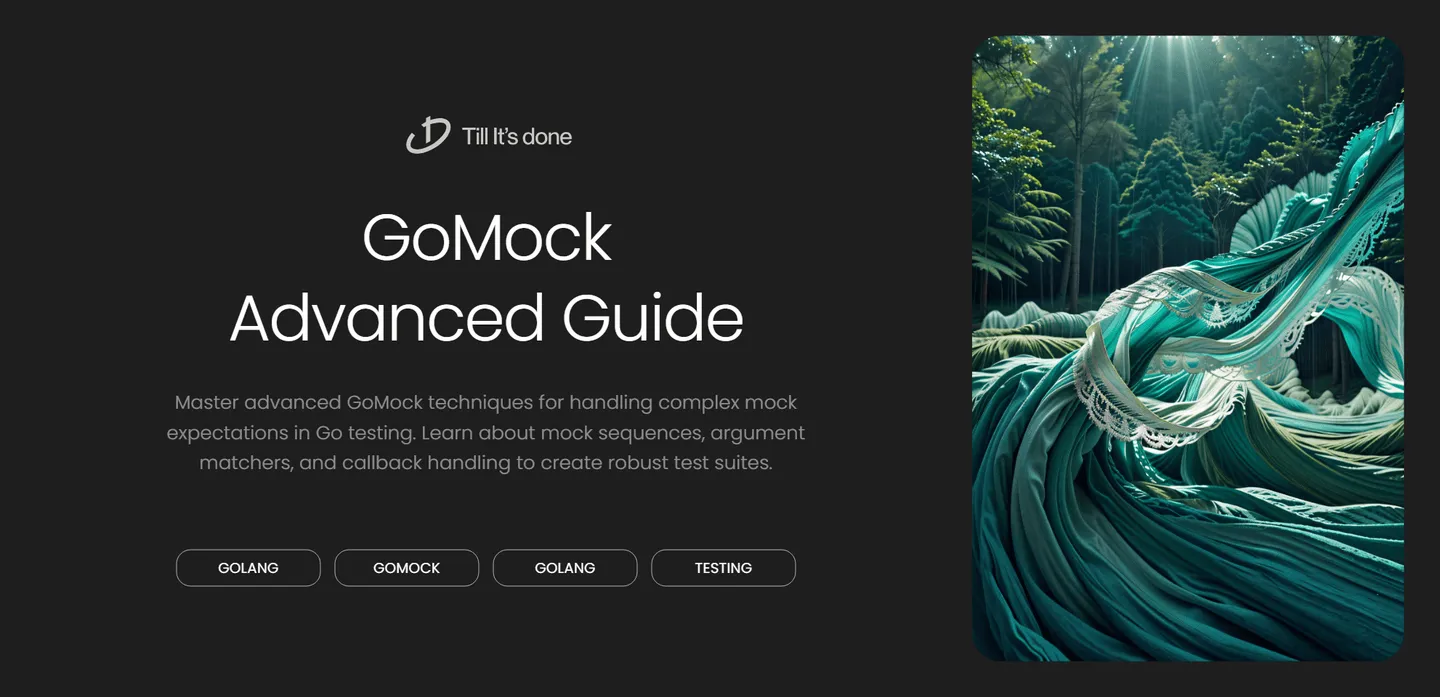- Services
- Case Studies
- Technologies
- NextJs development
- Flutter development
- NodeJs development
- ReactJs development
- About
- Contact
- Tools
- Blogs
- FAQ
Advanced GoMock Usage: Complex Mock Guide
Learn about mock sequences, argument matchers, and callback handling to create robust test suites.


Advanced GoMock Usage: Managing Complex Mock Expectations
Testing complex Go applications can be challenging, especially when dealing with intricate dependencies and service interactions. GoMock has become the go-to tool for creating mock objects in Go, but mastering its advanced features requires a deeper understanding. Let’s dive into some sophisticated techniques for managing complex mock expectations.

Understanding Mock Sequences
One of the most powerful features in GoMock is the ability to set up sequential expectations. Imagine you’re testing a payment processing system where the order of operations matters significantly:
ctrl := gomock.NewController(t)defer ctrl.Finish()
mockPayment := mock_payment.NewMockProcessor(ctrl)
// Expect these calls in sequencegomock.InOrder( mockPayment.EXPECT().ValidateCard().Return(true), mockPayment.EXPECT().ProcessPayment(gomock.Any()).Return(nil), mockPayment.EXPECT().SendReceipt().Return(nil),)Working with Argument Matchers
Sometimes we need to be flexible with our expectations while still maintaining meaningful assertions. GoMock provides powerful argument matchers that go beyond simple equality checking:
func TestUserService(t *testing.T) { ctrl := gomock.NewController(t) defer ctrl.Finish()
mockRepo := mock_repository.NewMockUserRepository(ctrl)
mockRepo.EXPECT(). SaveUser(gomock.AssignableToTypeOf(&User{})). DoAndReturn(func(u *User) error { if len(u.Email) == 0 { return errors.New("email required") } return nil })}
Advanced Callback Handling
GoMock’s DoAndReturn is incredibly powerful for implementing complex mock behaviors. Here’s how you can simulate stateful behavior:
func TestStatefulMock(t *testing.T) { ctrl := gomock.NewController(t) defer ctrl.Finish()
mockCache := mock_cache.NewMockCache(ctrl)
var stored map[string]interface{} = make(map[string]interface{})
mockCache.EXPECT(). Set(gomock.Any(), gomock.Any()). AnyTimes(). DoAndReturn(func(key string, value interface{}) error { stored[key] = value return nil })
mockCache.EXPECT(). Get(gomock.Any()). AnyTimes(). DoAndReturn(func(key string) (interface{}, error) { if val, ok := stored[key]; ok { return val, nil } return nil, errors.New("not found") })}Best Practices and Common Pitfalls
-
Avoid Over-specification: Only mock what you need to test your specific use case. Over-specifying mock expectations can make tests brittle.
-
Use Times() Wisely: Instead of
.Times(1)(the default), consider using.MinTimes(1)or.MaxTimes(2)for more flexible tests when appropriate. -
Clean Up Resources: Always use
defer ctrl.Finish()to ensure expectations are verified after the test completes. -
Maintain Test Readability: Group related expectations together and use helper functions to set up common mock scenarios.
Remember, the goal of mocking is to isolate the system under test while maintaining meaningful assertions. By leveraging these advanced GoMock features, you can create more robust and maintainable tests for complex Go applications.

 สร้างเว็บไซต์ 1 เว็บ ต้องใช้งบเท่าไหร่? เจาะลึกทุกองค์ประกอบ website development cost อยากสร้างเว็บไซต์แต่ไม่มั่นใจในเรื่องของงบประมาณ อ่านสรุปเจาะลึกตั้งแต่ดีไซน์, ฟังก์ชัน และการดูแล พร้อมตัวอย่างงบจริงจาก Till it’s done ที่แผนชัด งบไม่บานปลายแน่นอน
สร้างเว็บไซต์ 1 เว็บ ต้องใช้งบเท่าไหร่? เจาะลึกทุกองค์ประกอบ website development cost อยากสร้างเว็บไซต์แต่ไม่มั่นใจในเรื่องของงบประมาณ อ่านสรุปเจาะลึกตั้งแต่ดีไซน์, ฟังก์ชัน และการดูแล พร้อมตัวอย่างงบจริงจาก Till it’s done ที่แผนชัด งบไม่บานปลายแน่นอน  Next.js สอน 14 ขั้นตอนเบื้องต้น: สร้างโปรเจกต์แรกใน 30 นาที เริ่มต้นกับ Next.js ใน 14 ขั้นตอนเพียงแค่ 30 นาที พร้อม SSR/SSG และ API Routes ด้วยตัวอย่างโค้ดง่าย ๆ อ่านต่อเพื่อสร้างโปรเจ็กต์แรกได้ทันทีที่นี่
Next.js สอน 14 ขั้นตอนเบื้องต้น: สร้างโปรเจกต์แรกใน 30 นาที เริ่มต้นกับ Next.js ใน 14 ขั้นตอนเพียงแค่ 30 นาที พร้อม SSR/SSG และ API Routes ด้วยตัวอย่างโค้ดง่าย ๆ อ่านต่อเพื่อสร้างโปรเจ็กต์แรกได้ทันทีที่นี่  วิธีสมัคร Apple Developer Account เพื่อนำแอปขึ้น App Store ทีละขั้นตอน อยากปล่อยแอปบน App Store ระดับโลก มาอ่านคู่มือสมัคร Apple Developer Account พร้อมเคล็ดลับ TestFlight และวิธีอัปโหลดที่ง่ายในบทความเดียวนี้ได้เลย
วิธีสมัคร Apple Developer Account เพื่อนำแอปขึ้น App Store ทีละขั้นตอน อยากปล่อยแอปบน App Store ระดับโลก มาอ่านคู่มือสมัคร Apple Developer Account พร้อมเคล็ดลับ TestFlight และวิธีอัปโหลดที่ง่ายในบทความเดียวนี้ได้เลย  TypeScript Interface คืออะไร? อธิบายพร้อมวิธีใช้และข้อแตกต่างจาก Type เรียนรู้วิธีใช้ TypeScript Interface เพื่อสร้างโครงสร้างข้อมูลที่ปลอดภัยและเข้าใจง่าย พร้อมเปรียบเทียบข้อดีข้อแตกต่างกับ Type ที่คุณต้องรู้ ถูกรวมเอาไว้ในบทความนี้แล้ว
TypeScript Interface คืออะไร? อธิบายพร้อมวิธีใช้และข้อแตกต่างจาก Type เรียนรู้วิธีใช้ TypeScript Interface เพื่อสร้างโครงสร้างข้อมูลที่ปลอดภัยและเข้าใจง่าย พร้อมเปรียบเทียบข้อดีข้อแตกต่างกับ Type ที่คุณต้องรู้ ถูกรวมเอาไว้ในบทความนี้แล้ว  Material-UI (MUI) คืออะไร อยากสร้าง UI สวยงามและเป็นมืออาชีพในเวลาอันรวดเร็วใช่ไหม มาทำความรู้จักกับ Material-UI (MUI) ที่ช่วยให้คุณพัฒนาแอปพลิเคชันบน React ได้ง่ายและดูดีในทุกอุปกรณ์
Material-UI (MUI) คืออะไร อยากสร้าง UI สวยงามและเป็นมืออาชีพในเวลาอันรวดเร็วใช่ไหม มาทำความรู้จักกับ Material-UI (MUI) ที่ช่วยให้คุณพัฒนาแอปพลิเคชันบน React ได้ง่ายและดูดีในทุกอุปกรณ์  เปรียบเทียบ 3 วิธีติดตั้ง install node js บน Ubuntu: NVM vs NodeSource vs Official Repo แบบไหนดีที่สุด? เรียนรู้วิธีติดตั้ง Node.js บน Ubuntu ด้วย NVM, NodeSource หรือ Official Repo เลือกวิธีที่เหมาะกับความต้องการของคุณ พร้อมเปรียบเทียบ เพื่อการพัฒนาที่มีประสิทธิภาพ!
เปรียบเทียบ 3 วิธีติดตั้ง install node js บน Ubuntu: NVM vs NodeSource vs Official Repo แบบไหนดีที่สุด? เรียนรู้วิธีติดตั้ง Node.js บน Ubuntu ด้วย NVM, NodeSource หรือ Official Repo เลือกวิธีที่เหมาะกับความต้องการของคุณ พร้อมเปรียบเทียบ เพื่อการพัฒนาที่มีประสิทธิภาพ! Talk with CEO
We'll be right here with you every step of the way.
We'll be here, prepared to commence this promising collaboration.
Whether you're curious about features, warranties, or shopping policies, we provide comprehensive answers to assist you.


